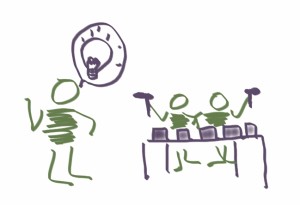A Few Thoughts about Collaboration
The definition of collaboration in any given context is variable. It can be as simple as two people working on a task or as complicated as international diplomatic relations and anything in between.
Some people might think that collaboration means agreement, but some of the best outcomes have happened when people with very different views work together.
One of the problems with trying to solve problems is our inherent biases. We have only lived our own lives and therefore make decisions and contributions based on our experiences. It is easy to make assumptions without realising it, so when we are collaborating, it is important to check our assumptions with each other and make sure that what we are working on is an agreed view of the work.
Collaboration is not a static point but a dynamic interaction between the task at hand and the participants including their experiences and the interpretations they bring to the “table”.
A Couple of Misconceptions
1: Everyone is created equal
Almost everyone doesn’t like to hear this one but we are not created equally, if we were, it would be so boring, and we would all be the same carbon copies of each other, same job, same life and same house. Some of us find doing certain things easier than others, this does not mean they are better than someone else but have a predisposition towards that particular thing. This is actually the strength of any collaboration, we are not a monoculture or genetically engineered workers but individuals with different perspectives and abilities. This is the core of collaboration and teamwork.
2: Everyone must carry their own weight and do their share.
Collaboration/ Teamwork is rarely a balanced interaction (50/50 etc.) but most realistically an imbalanced one. The beginnings are like a “seed”, an idea of a purpose and/or direction, however the “seed” does not contain all the materials and experience to develop into the eventual “plant”. The contribution of the seed if measured by biological bulk is minute and of little significance; yet without the direction and/or purpose there is no “plant”.
Perhaps we should consider this when we think about the share of workload in teams and remember that a small effort that provides a large weight of outcome can be just as good as a large effort.
 When we discuss collaboration and teamwork we often begin to weigh the obvious, visible efforts that people are putting in and lose sight of the reality. Without the idea, thought and then the effort, the experience is a barren one. The ego and self often confuse and stifle the collaboration from becoming. We should check our Ego’s at the door and be open to ideas and possibilities regardless of where they may come from.
When we discuss collaboration and teamwork we often begin to weigh the obvious, visible efforts that people are putting in and lose sight of the reality. Without the idea, thought and then the effort, the experience is a barren one. The ego and self often confuse and stifle the collaboration from becoming. We should check our Ego’s at the door and be open to ideas and possibilities regardless of where they may come from.
In summary – the differences in backgrounds, ideas and effort can undermine any team and result in very poor outcomes, however, it is these very same differences that can make any collaborative effort a great one and open opportunities for innovation, increased effectiveness and workplace enjoyment. How can we turn our thinking towards the positive outcomes from differences and ensure that we leverage these as much as possible?
- Allow people to come up with their own contributions whenever possible and then share them – this will prevent premature convergence and make differing assumptions easier to detect.
- When we feel that others are not pulling their weight, check that we are not just observing effort and instead look for contribution towards the outcome.
- Recognise that different people are good or great at different things and try to avoid creating teams of very similar people or skillsets.
- Use the different perspectives and backgrounds of other people to help us see things that we are overlooking – another good reason to have people with diverse experiences in teams.
Thank you to Torbjörn Gyllebring and Steve again for the discussions that inspired this post and Steve for contributing some paragraphs and editing. Any faults with this post, however, are my own.
Torbjörn Gyllebring’s post is about Estimates and Theory Building
